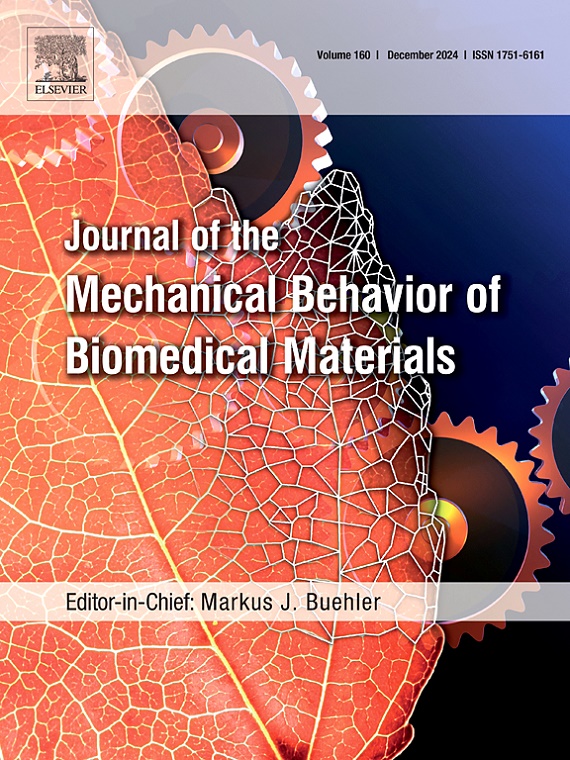实验短纤维增强CAD/CAM复合材料的边缘质量、均匀性和内部孔隙率评估。
IF 3.3
2区 医学
Q2 ENGINEERING, BIOMEDICAL
Journal of the Mechanical Behavior of Biomedical Materials
Pub Date : 2024-12-12
DOI:10.1016/j.jmbbm.2024.106867
引用次数: 0
摘要
研究目的本研究的目的是评估实验性短纤维增强 CAD/CAM 复合材料(SFRC CAD)块在循环疲劳老化前后的前牙冠边缘质量。此外,与其他商业 CAD/CAM 材料相比,还要研究 SFRC CAD 的微观结构、均匀性和孔隙率。方法:用五种 CAD/CAM 块铣制 40 个前牙冠,分为五组(n = 8/组)。第一组是二硅酸锂陶瓷块(EM),第二组是氧化锆增强二硅酸锂陶瓷块(CD),第三组是混合聚合物渗透陶瓷网络块(VE),第四组是混合纳米粒子填充树脂块(CS),最后一组是 SFRC CAD 陶瓷块(SFRC)。使用体视显微镜检查牙冠,并使用 FIJI 软件测量边缘的不规则性。使用微型计算机断层扫描(micro-CT)对试样进行扫描,以检查孔隙率和均匀性。然后对冠体进行循环疲劳老化(120,000 次,Fmax = 220 N),并再次测量边缘不规则度。采用 SEM/EDS 和 XPS 分析:结果:与循环疲劳老化前后的其他组相比,SFRC CAD 组的边缘不规则度值最小,而二硅酸锂组的边缘不规则度值最大(p 有学意义:材料类型和疲劳老化对牙冠边缘不整齐度有显著影响。混合材料组和树脂基组的边缘不整齐程度低于陶瓷基组。在成像分辨率范围内,所有测试材料都具有内部孔隙率低的均匀结构。本文章由计算机程序翻译,如有差异,请以英文原文为准。

Margin quality, homogeneity, and internal porosity assessment of experimental short fiber-reinforced CAD/CAM composite
Objectives
The aim of this study was to evaluate the margin quality of anterior crowns made of experimental short fiber-reinforced CAD/CAM composite (SFRC CAD) block before and after cyclic fatigue aging. Moreover, to investigate the microstructure, homogeneity, and porosity of the SFRC CAD compared with other commercial CAD/CAM materials.
Methods
40 anterior crowns were milled from five CAD/CAM blocks divided into five groups (n = 8/group). The first group was made of lithium disilicate ceramic blocks (EM), the second of zirconia-reinforced lithium disilicate blocks (CD), the third of hybrid polymer-infiltrated ceramic network blocks (VE), the fourth of hybrid nanoparticle-filled resin blocks (CS), and the last of SFRC CAD blocks (SFRC). Crowns were inspected with stereomicroscope and margins irregularities were measured using FIJI software. Specimens were scanned using micro-CT to investigate porosity and homogeneity. Crowns were then subjected to cyclic fatigue aging (120,000 cycles, Fmax = 220 N) and margin irregularities were measured again. SEM/EDS and XPS analyses were employed.
Results
SFRC CAD group resulted in the least margin irregularity values compared to other groups before and after cyclic fatigue aging, and lithium disilicate group resulted in the highest margin irregularity values (p < 0.05). Micro-CT scanning revealed a homogenous distribution of fillers of tested materials with low internal porosity.
Significance
Material type and fatigue aging significantly affect crown margin irregularities. Hybrid and resin-based groups resulted in less margins irregularities than ceramic-based ones. All tested materials have homogenous structures with low internal porosity within the range of imaging resolution.
求助全文
通过发布文献求助,成功后即可免费获取论文全文。
去求助
来源期刊

Journal of the Mechanical Behavior of Biomedical Materials
工程技术-材料科学:生物材料
CiteScore
7.20
自引率
7.70%
发文量
505
审稿时长
46 days
期刊介绍:
The Journal of the Mechanical Behavior of Biomedical Materials is concerned with the mechanical deformation, damage and failure under applied forces, of biological material (at the tissue, cellular and molecular levels) and of biomaterials, i.e. those materials which are designed to mimic or replace biological materials.
The primary focus of the journal is the synthesis of materials science, biology, and medical and dental science. Reports of fundamental scientific investigations are welcome, as are articles concerned with the practical application of materials in medical devices. Both experimental and theoretical work is of interest; theoretical papers will normally include comparison of predictions with experimental data, though we recognize that this may not always be appropriate. The journal also publishes technical notes concerned with emerging experimental or theoretical techniques, letters to the editor and, by invitation, review articles and papers describing existing techniques for the benefit of an interdisciplinary readership.
 求助内容:
求助内容: 应助结果提醒方式:
应助结果提醒方式:


